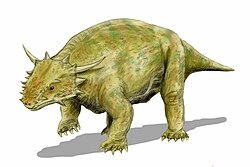| Mandaphon Temporal range: Middle Triassic | |
|---|---|
| Scientific classification | |
| Domain: | Eukaryota |
| Kingdom: | Animalia |
| Phylum: | Chordata |
| Clade: | † Parareptilia |
| Order: | † Procolophonomorpha |
| Family: | † Procolophonidae |
| Subfamily: | † Leptopleuroninae |
| Genus: | † Mandaphon Tsuji, 2018 |
| Type species | |
| †Mandaphon nadra Tsuji, 2018 | |
Mandaphon is an extinct genus of procolophonid from the Middle Triassic Manda Formation of Tanzania. It contains a single species, Mandaphon nadra. [1]

